specINTI & specINTI Editor
Appendix 2: Pol’Ex : The « Pollution Explorer »
The pollution of the sky by artificial lighting is a calamity for all astronomers, amateurs or professionals, and rightly so. By lightening the night sky, this parasitic light prevents us from perceiving the splendors of the astronomical sky, whether we are neophytes (the Milky Way is no longer visible in cities), deep sky amateurs, or researchers. More generally, all nature lovers are victims. There is no counting the number of animal species that are disturbed or endangered because of the illumination of monuments, aggressive street lamps and commercial areas that spend energy in pure waste.
The situation is made worse by LED lighting. The alleged savings of this technology is a clear deception, but few people are aware of it and among them are many elected officials. This LED lighting appears to some as a solution of progress that is used excessively since it is deemed economical, to finally have a zero energy balance, or even worsened. The installation and maintenance of this lighting are not free either (a lot of electronics and rare materials used, and it is not sure that the ecological balance is so positive). Moreover, the spectrum of these LED lamps is unnatural, with an excess of blue that can cause physiological disorders, and even accidents (in cars, for example). And the story of the thieves at night, so often advanced: thanks to the street lamps, the said aggressors are licking their lips to see their victims well, to choose their target well and to notice that the environment is quiet. Urban lighting based on LEDs, used to excess, appears to be a false good solution. But it is not too late to act and move in the right direction.
Some municipalities have become aware of all these problems. They have the intelligence to take the initiative to turn off or limit urban lighting late at night. The results are positive for public finances and for the environment. It is important to support these actions and more generally all those who fight for the preservation of the night sky. But since any good solution to a problem requires a good diagnosis, it is essential to measure light pollution and to follow its evolution to act in the most efficient way.
Measuring the luminance of the sky with calibrated photometers is a good way to track light pollution. However, it is possible to obtain a more precise analysis by taking into account the spectral distribution of this source of disturbance. This is the objective of Pol’Ex, the "Pollution Explorer", which realizes the precise spectrum of the night sky, both inside and outside a city, in the countryside, in the mountains and in astronomical observatories where the evolution of the pollution of the night sky is monitored very closely. The idea is to better understand the nature of pollution sources, to analyze their evolution over time, to geolocate critical areas, and then to implement solutions with full knowledge of the facts.
There are devices that already do this type of work, and very well. But the idea of Pol'Ex is to make this type of system less expensive, by aiming at a large diffusion. It also makes the users real actors who inform themselves, learn, and eventually act. Making a class of students aware of the difference between sunlight, which has shaped our vision, and aggressive artificial lighting, which destroys this vision, is a real educational experience and training of responsible citizens.
It would be a real shame to miss this when you own a Sol'Ex or a Star'Ex, inexpensive and simple instruments that you can make yourself by printing them using 3D technology (they can also be obtained from other sources). This design and use is part of a purposeful approach to learning: make, measure, analyze and act. The instrument is so simple and attractive that it would be reasonable to see it become widespread everywhere: in town halls, schools, universities, at home and in observatories. One can imagine a data bank that centralizes all this precious spectral information, making for example a distinction between a cloudy or clear sky depending on the time of day, or to make absolute measurements that are the basis of territorial maps of light pollution or standards for other instruments, including satellite.
Basically, Pol'Ex is a Star'Ex LR (Star'Ex "Low Resolution"). The only difference is that no telescope is used for the measurements. The operating mode is much simpler since one simply aims upwards (zenith) to capture the sky light.


Arrangement of Pol'Ex during the measurements. Here we made a small support in 3D printing to hold the instrument (you can download the STL of this support by click here).
On the more technical side, Pol'Ex is equipped with the classic 300 lines/mm grating, the specially optimized 80 mm x 80 mm optics (available from the Shelyak company) and a 23 micron or 35 micron entrance slit. A cooled CMOS camera (type ASI533MM Pro ideally) completes the device, but you can also obtain, with more patience, a result with an uncooled CMOS camera, more economical.
Is Pol'Ex powerful ? Yes, of course, and that is why it is presented here. Some will tell you that you have to use a less dispersive diffraction grating (the element that spreads the colors of the spectrum), some will tell you that you have to change the optics of the spectrograph, some will tell you that you have to put a very bright optic at the entrance of Pol'Ex... None of this. I considered here that who little the more little the less. The obtained spectra are particularly resolved, very fine (the fineness is better than 1 nanometer at the base), surely too much for the primary need. But this is without counting on the properties of Pol'Ex (or Star'Ex) and the tools that accompany it. Let's take a look.
First of all Pol'Ex is a wide field spectrograph, with a 4.5 mm long slit, which is very sharp over the whole height of the spectrum. This means that to obtain the spectral signature of the night sky it is possible to make a massive agglomeration of several hundred lines of the detector, even several thousand lines. The signal to noise ratio is then drastically increased. At this stage, and given the resolution, you can already make very advanced analyses, such as measuring the natural pollution of the sky, coming from the upper atmosphere of the Earth (see below).
Then, there is nothing to prevent you from agglomerating columns after columns (this is called spectral binning), which degrades the spectral resolution, but on the other hand reduces the measurement noise. You are free to set the parameters of this operation, for example to go down to a resolution of 50 nm if you wish. You thus have at hand a very flexible instrument with variable geometry, which is not possible with a specialized configuration. For processing, the specINTI software, or any other software of your design, can do the job. For what concerns specINTI refer to appendix 1, and the description of the Lab'Ex extension, the processing procedures are very similar (so in almost one click when everything is well calibrated).
Putting an optic in front of Pol'Ex brings nothing, except problems: a cost, an adjustment, fogging. Nothing, absolutely nothing in front of the slit, except a small diaphragm of 15 mm diameter which delimits the geometrical range of observation. We are measuring the luminance of a uniform scene, so a lens in front of the slit is of little interest.
This short appendix is not intended to describe in detail the procedures of use and data analysis, this will be the subject of specific documents. Let's say that things are simple and quite natural: for example, to calibrate in wavelength, in true spectral distribution, and even in absolute flux (real physical measurements of the sky, in Watt/steradian/micron for example), you can for example rely on a banal, but very effective daytime measurement with a white screen illuminated by the Sun:
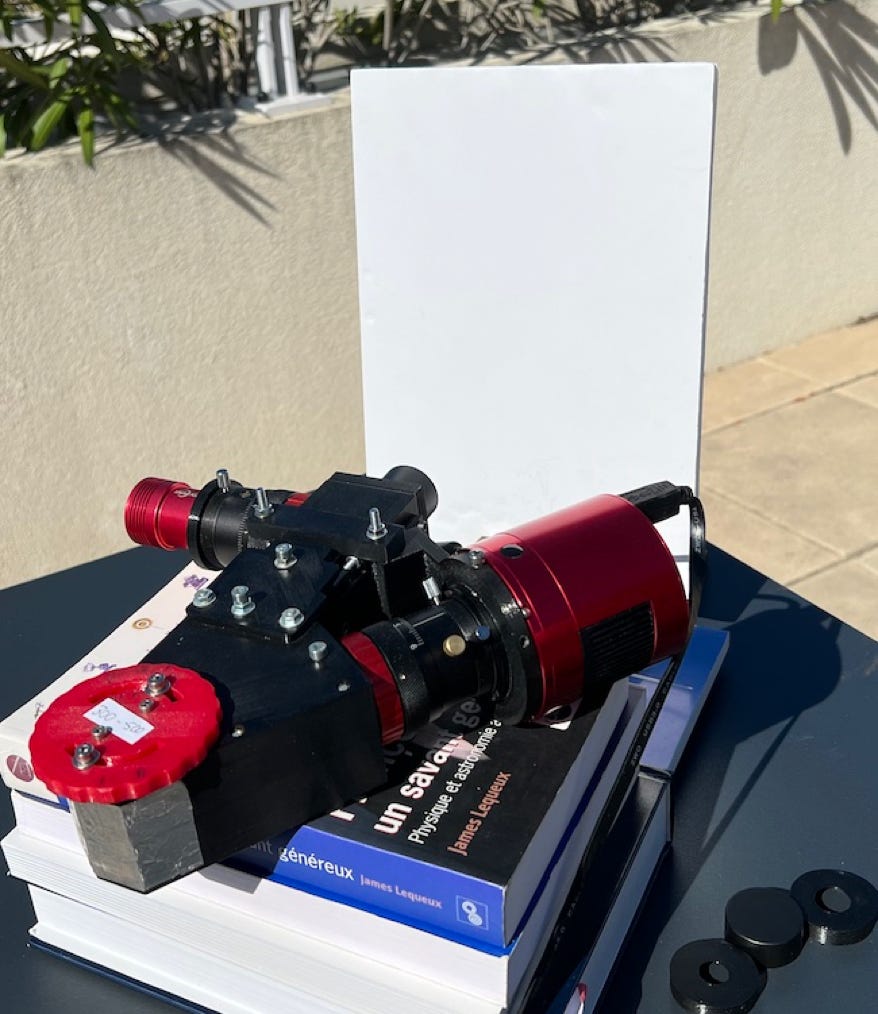
A necessary tool is a small improvised sundial to measure the angular height of the Sun and to finally take into account the atmospheric transmission during the calculations (very simple to evaluate). We add a drawing board, which is a very neutral spectral reflector, and some good books as support:

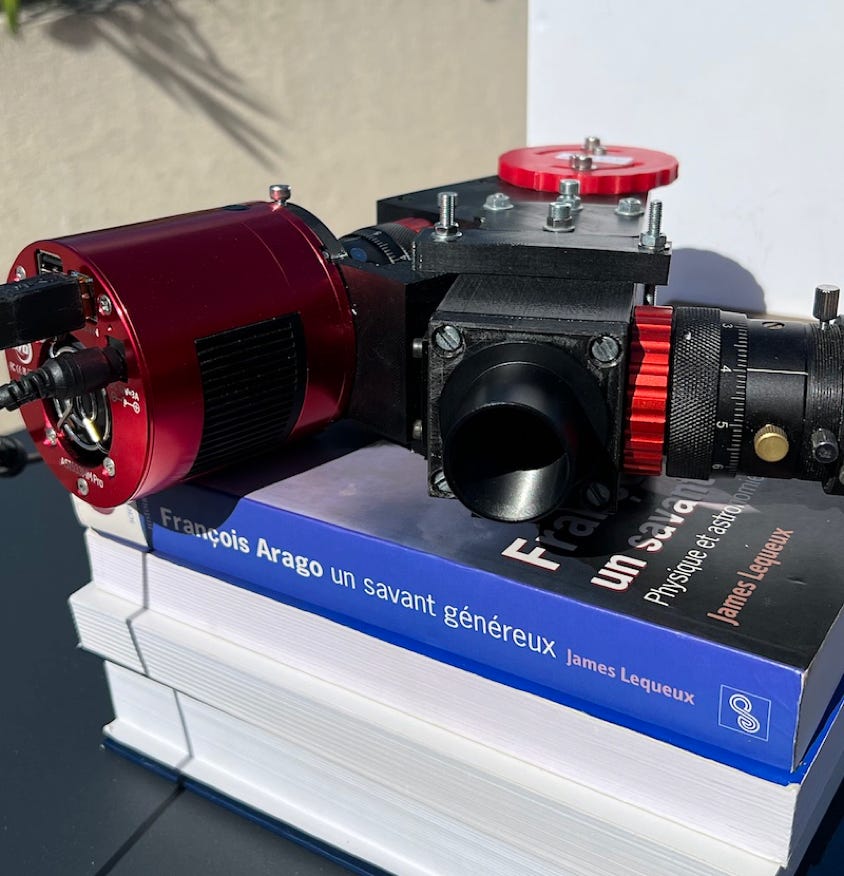
Here is a sample of background spectra obtained by Pol'Ex (urban contions):
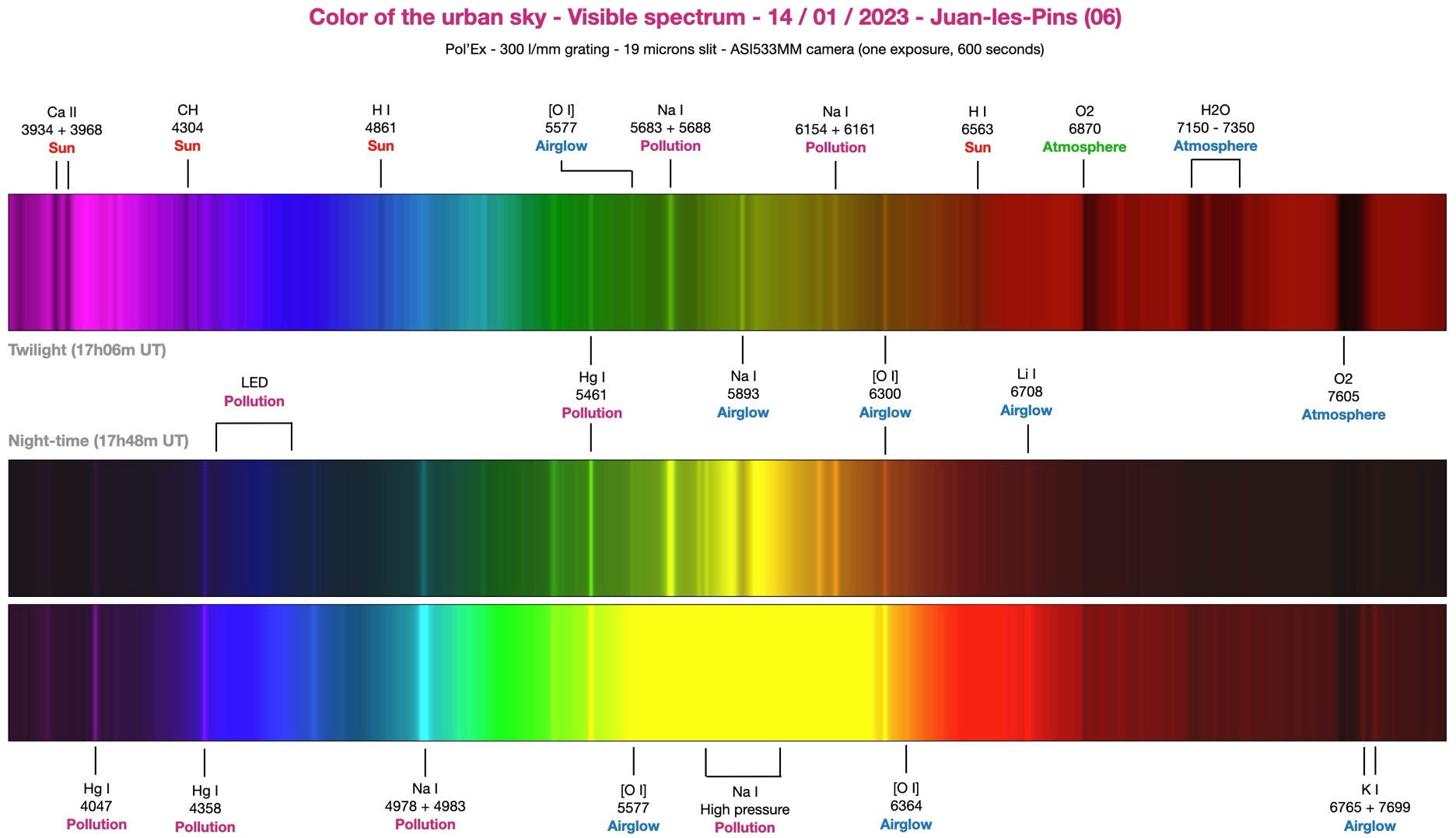
The top spectrum was taken at twilight, when the Sun was already below the horizon, but its rays were still illuminating the upper atmosphere of the Earth up to about 100 km altitude. The color of the sky changes rapidly at this time. We observe mainly fine lines emitted by our own atmosphere in the stratosphere, a kind of natural and discrete light pollution. It is important to note the emission of the sodium doublet (there is of course sodium at these high altitudes!), which appears quite briefly. This is an interesting phenomenon to observe and provides information about our atmosphere (we call it airglow).
Below, we have two characteristic nighttime spectra of Juan-Les-Pins, a seaside resort on the French Riviera, which borders the city of Antibes (more populated than Cannes, not far from there). Light pollution is very present, with high pressure sodium streetlights (which give a characteristic yellow color, with some fine lines of mercury). There is also a strong increase in blue intensity due to light pollution by LED lighting. In the middle of all this, to show the interest of acquiring data with a relatively high spectral resolution, it is worth noting the presence of green and red lines of atmospheric oxygen ([OI]) - these are the same lines that give their colors to the draperies of the polar auroras. It is even possible to observe auroras in temperate zones thanks to the spectrograph. It is interesting to note that Pol'Ex is able to detect the atmospheric lines of lithium (Li) and potassium (K), whose presence is rather rare. These lines are probably induced by the combustion of meteorites in the atmosphere. Detecting this spectral signature is remarkable for an instrument built at low cost with a 3D printer!
It is also important to know that there is a near infrared version of Star'Ex and thus, an infrared version of Pol'Ex. Here is the aspect of the night sky in Antibes/Juan-les-Pins, obtained under the same conditions as before:
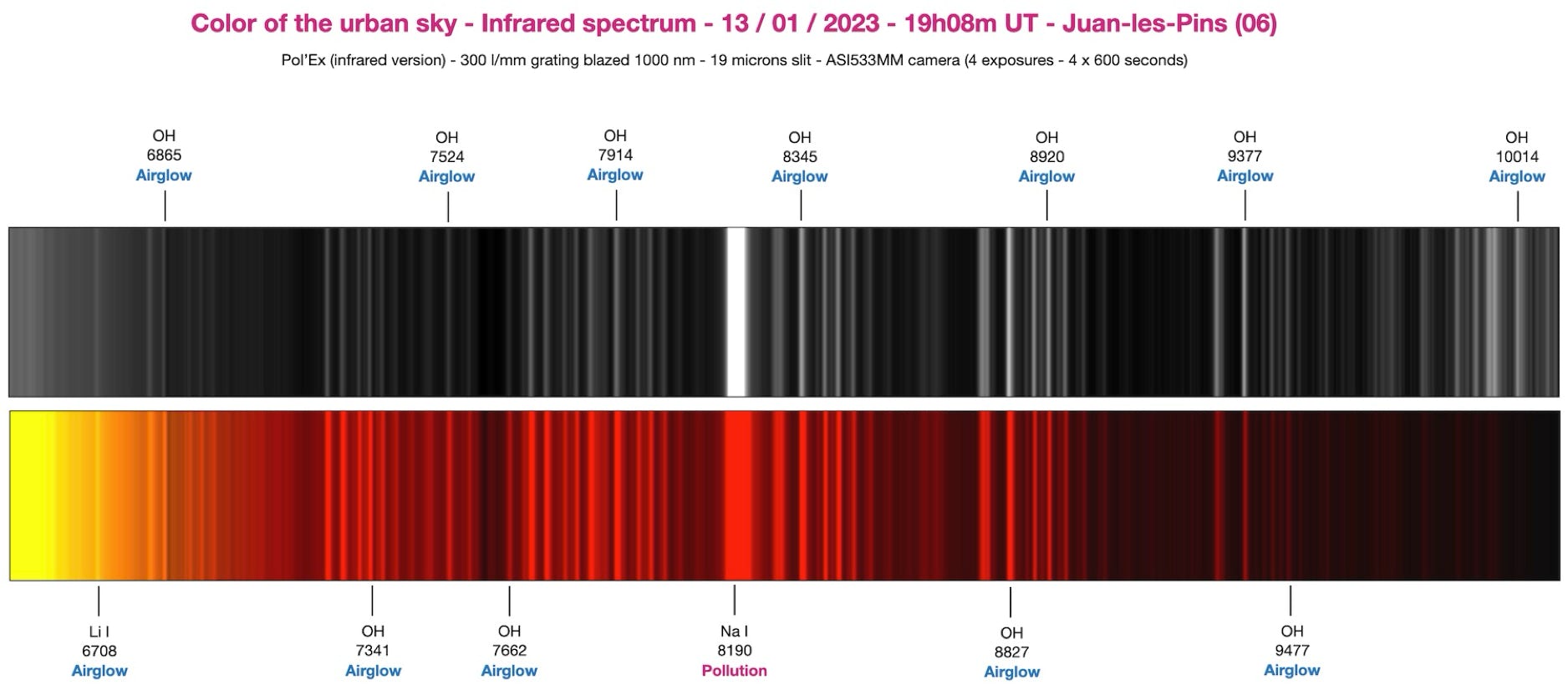
This time, it is the OH radical, here again a molecule present in the upper atmosphere which represents the main source of pollution. Do not be mistaken, the intensity of this spectrum is very low, but it will be of particular interest to professional astronomers and geophysicists.
Of course, I do not teach you that light pollution affects our astronomical observations, photographic or spectrographic, with a small advantage for spectrography because by image processing, it is possible to erase to some extent this pollution. Here is an example which concerns an observation of comet C/2022 E3 (ZTF), with Star'Ex, in an intermediate resolution mode, top with pollution and bottom without pollution (removed digitally):
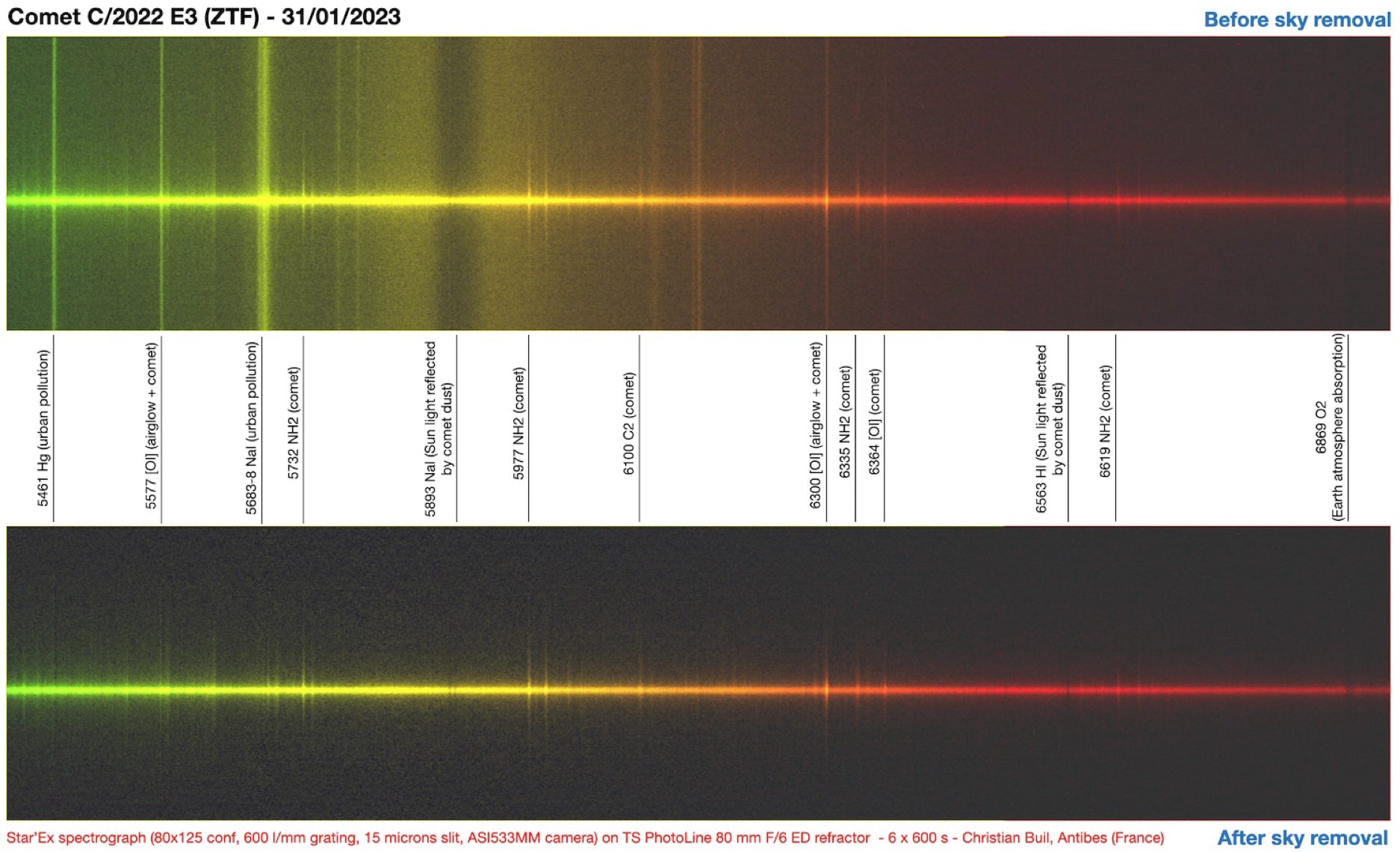
To better "appreciate" the damage of light pollution, here are two spectral images of the Messier 1 nebula made from the city of Antibes with Star'Ex LR 300 t/mm and a 35 micron slit at the focus of a 150 mm Newton telescope opened at f/4, the exposure time being one hour:


Messier 1 (or "Crab Nebula") is a well-known supernova afterglow, a nebula expanding at high speed. This is the reason why the line images of this nebula show a ring structure, related to the velocity effect of the gases whose image is cut by the entrance slit (a sectracular Doppler-Fizeau effect). The spectrum shows emission lines of hydrogen, nitrogen, sulfur, oxygen... In the upper image, the polluted sky background is not removed and we see how it is more intense than the nebula (it is true that the telescope is pointing low and above the lights of the city of Cane, not far away). At the bottom, the sky background is digitally removed, but the photon noise from it remains, which reduces the "detectivity". The horizontal diffuse band is real and caused by synchrotron radiation inside the nebula, the magnetic field being important.
There is much more to say and do, this is only the beginning of a story!
If you see the need and want to have more information, contact christian Buil, the author of these lines and of the Sol'Ex/Star’Ex project: christian.buil-at-wanadoo.fr